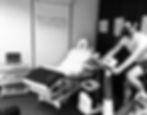Service Spotlight - VO2 max Analysis (Performance & Longevity)
- Neil Livemore
- Nov 10, 2022
- 3 min read
Updated: Oct 13, 2024

What is VO2 max?
VO2 max is viewed as the scientific gold standard in determining physical fitness.
It is a simple test completed with advanced laboratory equipment to assess cardiovascular fitness which correlates to health and performance.
V = Volume
O2 = Oxygen
Max = Maximum
The VO2 max score is an indicator of overall aerobic fitness (think engine size) and the maximum amount of oxygen the body can breathe in and utilise during maximum work.
How do we performance a VO2 max analysis?
Each participant prepares a specific way to standardise the VO2 max analysis and ensure accuracy of the measurement and accuracy for future measurements and comparison. A heart rate monitor and face mask (example below) are worn to analyse heart rate and air breathed in and out throughout the analysis.
As the test begins, the intensity gradually increases in a graded manner until exhaustion is reached and perceived as maximal effort.
Afterwards, we can look at the data showing how much oxygen you used as you exercised and view:
Overall fitness.
Maximal oxygen you can consume and utilise.
VO2 max (modified to body mass) and range it lies (Poor - Superior)
Heart rate data
Calorie expenditure at given intensities.
Training zones (estimated or via lactate testing)

Why is it important?
Athletes
VO2 max allows us to benchmark your current position, compare to the expected levels in your sport, monitor progress and evaluate changes in fitness and the impact of the specific training phase.
Non-athletes (cardiovascular fitness for performance and longevity)
If you are exercising or a recreational athlete, the above athlete benefits still apply. For those focussing on general health, fitness and longevity, VO2 max strongly correlates with cardiovascular health, all-cause mortality and longevity.

The above chart shows poor to superior VO2 max values for men and women. It's also important to note that various factors can impact VO2 max, such as fitness levels, age, gender and body mass. As you can see, VO2 max levels reduce as we age, so it's important to know where your results lie for your specific attributes. VO2 max also correlates with all-cause mortality and life expectancy.

The graph above (Mandsager et al., 2018) shows findings from an observational study of 120,007 individuals (male and female), and the risk reduction at various levels of fitness for all cause mortality (e.g. diabetes, coronary artery disease: smoking, high blood pressure).
For reference, low was the bottom 25th percentile, high was the top 75th percentile, and elite was the top few percent. As you can see, the most significant differenceis going from low to below average, then below average to above average.
These examples show the importance of cardiovascular fitness for longevity and cardiovascular health.
Luckily, we can improve our VO2 max levels.
How can you improve your VO2 max?
Increasing the amount and intensity of your exercise and training can help you gradually improve your VO2 max. The correct activity, exercise or training will increase the amount of blood your heart can pump and the amount of oxygen your muscles can use.
Simple aerobic exercises are an excellent place to start; this includes jogging, running, cycling, swimming, and even walking for some. As the pace becomes easier, intensity can be increased.
Body composition and mass, as VO2max values are formulated per kg of body mass, reducing body fat to healthy levels can enhance your overall score.
Avoiding deficiencies in nutrients (e.g. iron) can also compromise performance.
References
--------------------
How can we help support your goals?
Individual consultancy
Nutritional support and development process
Assessments
Physiological testing
Team support
Team education
Mentoring
Interested in our primary services?
FREE PHONE CONSULTANCY
Use the contact form below to request more information or arrange a free phone call to discuss your needs.



